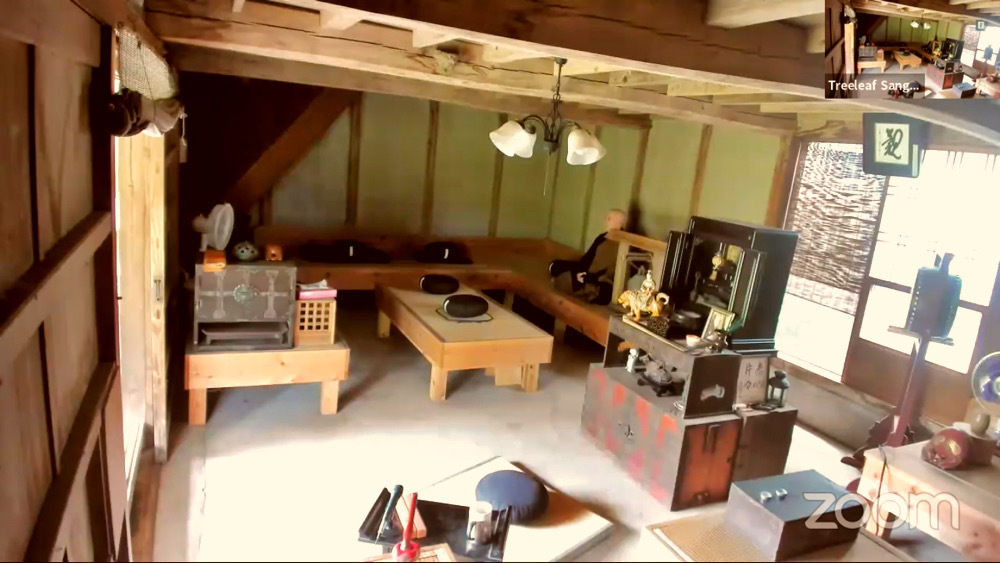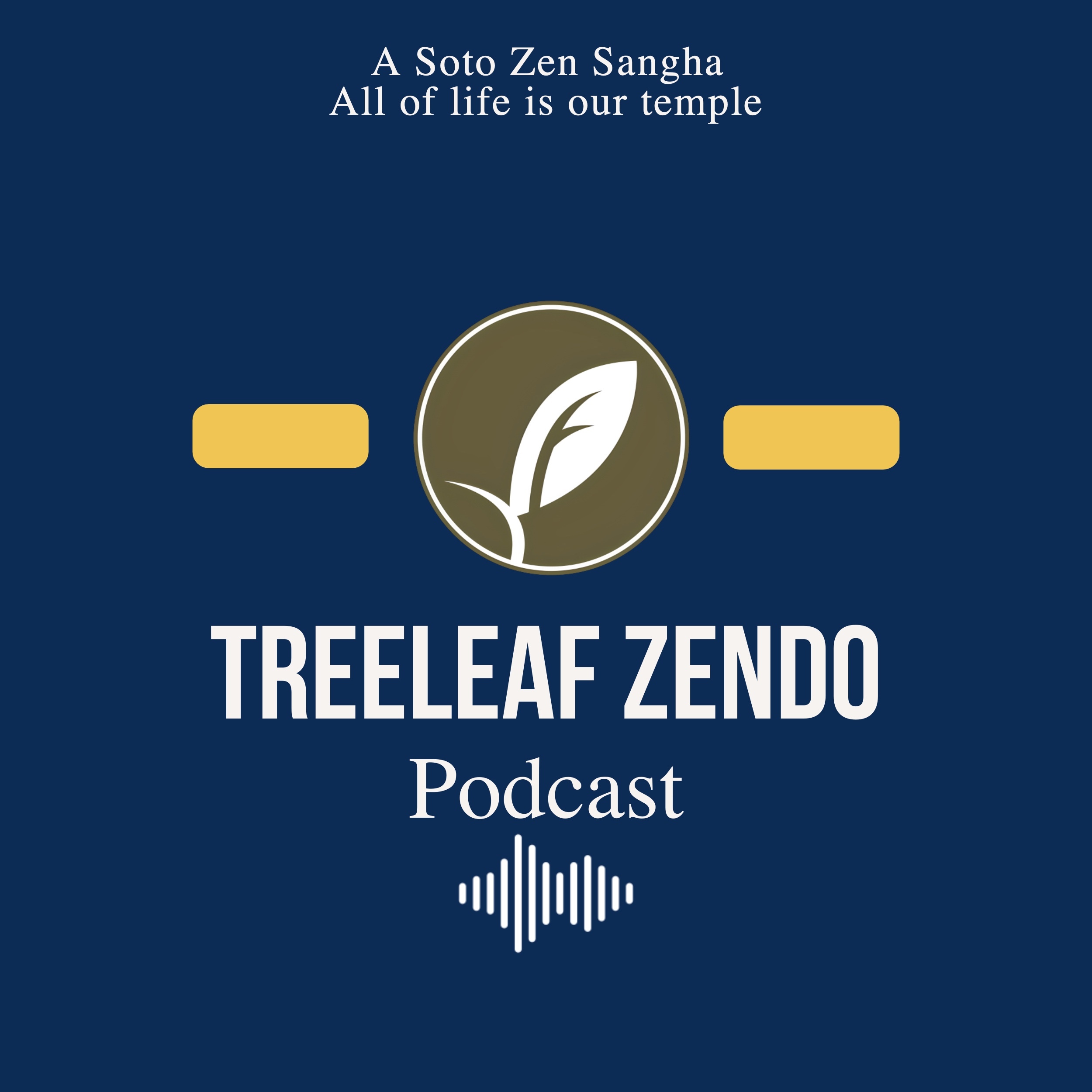Episodes
Episodes



Monday Oct 18, 2010
Cloud Self
Monday Oct 18, 2010
Monday Oct 18, 2010
This lovely poem of Dogen is an attempt to convey through sound and breaths his real and original face. The mountain of samadhi, the moon of awakening, the white and changing nature of rice, cloud and water. This is also a precise description of what takes plcae when one sits, the no-self being realised when everything is invited adn included in a lively process of expanding in all directions.
On a portrait of myself
1249, Echizen
Fresh, clear spirit covers old mountain man this autumn.
Donkey stares at the sky ceiling: glowing white moon floats.
Nothing approaches. Nothing else included.
Buoyant, I let myself go~filled with gruel, filled with rice.
Lively flapping from head to tail,
sky above, sky beneath, cloud self, water origin.
Visit the Forum for this topic!



Saturday Oct 16, 2010
What Makes You Think?
Saturday Oct 16, 2010
Saturday Oct 16, 2010
NOTE: PART OF END OF TALK WAS CUT OFF ... BUT THE POINT GETS ACROSS!
There's an old Chinese story about the son and the broken leg ...
A farmer had only one horse, and one day the horse ran away. The neighbors came to console him over his terrible loss. The farmer said, "What makes you think it is so terrible?"
A month later, the horse came home--this time bringing with her two beautiful wild horses. The neighbors became excited at the farmer's good fortune. Such lovely strong horses! The farmer said, "What makes you think this is good fortune?"
The farmer's son was thrown from one of the wild horses and broke his leg. All the neighbors were very distressed. Such bad luck! The farmer said, "What makes you think it is bad?"
A war came, and every able-bodied man was conscripted and sent into battle. Only the farmer's son, because he had a broken leg, remained. The neighbors congratulated the farmer. "What makes you think this is good?" said the farmer.
Visit the Forum for this topic!



Wednesday Oct 13, 2010
Stone Woman Dancing
Wednesday Oct 13, 2010
Wednesday Oct 13, 2010
An old Zen poem, the 'Song of the Jewel Mirror Samadhi' ...
When the wooden man begins to sing, The stone woman gets up to dance.
Visit the Forum for this topic!



Saturday Oct 09, 2010
Avoiding The Jive And Hype
Saturday Oct 09, 2010
Saturday Oct 09, 2010
It’s almost to the point that there’s a flavor of Buddhism for everyone, especially in the West! From A is for Amida to Z is for Zen, there are groups and teachings of all stripes … the monastic and the “out in the world” types … traditional and tradition breaking … many teachers in between, mixing and matching. The Western Buddhist world comes in ten thousand colors and flavors!
And that can be GOOD! I have never been a “my way or the highway, one size fits all” kind of Buddhist. Different folks may require different medicines for what ails them. Find the path and teacher(s) right for you.
All you have to do, though, is avoid the snake oil, the image driven jive and hype, soothing but empty cliches, crazy cults, charismatic charlatans and ego maniac gurus professing “freedom from ego”, downright crooks and con-men, New Age dribble and pseudo-psycho-babble, fast food drive-though spirituality. Also, don’t fall into “spiritual materialism” … shopping around in the Dharma department store for the fluffy and flashy, for teachers of ‘anything goes, feel good philosophies’, “teachings” that just say what we want to hear (and not what we need to hear). Oh, and if you do stumble on a worthwhile practice, be sure not to quit too fast … as soon as it becomes a little demanding.
Do all that … and you’ll be just fine!
Visit the Forum for this topic!



Wednesday Oct 06, 2010
What We Think Others Think
Wednesday Oct 06, 2010
Wednesday Oct 06, 2010
The topic came up in another thread about worrying too much about what others think of us ...
I have a tendancy to take a lot of what people say to me, personal. ... Can anyone give me some tips from a buddhist or zen-perspective, how to stop myself from constantly being so busy with what other people think of me (or, better put: what I think that other people think of me)
Link to thread
Well, ultimately there is no "you" there, nor "others" ... so no need for you to worry what others think!
However, even before one gets to such an ultimate Truth ... there's much Wisdom that Shikantaza Practice can offer to free us from opinions, from self judgments, imaginings and the like. Let them go, let them drift from mind!
What's more ... you are a jewel, just as you are! Not a thing to change! (which doesn't mean, however, that you don't have some flaws, my friend, in need of change! )
Gassho, Jundo
Visit the Forum for this topic!



Sunday Oct 03, 2010
Genjo Koan - Fanning Space
Sunday Oct 03, 2010
Sunday Oct 03, 2010
Dogen writes: Do not suppose that what you realize becomes your knowledge and is grasped by your consciousness. Although actualized immediately, the inconceivable may not be apparent. Its appearance is beyond your knowledge. Zen master Baoche of Mt. Mayu was fanning himself. A monk approached and said, "Master, the nature of wind is permanent and there is no place it does not reach. When, then, do you fan yourself?"
"Although you understand that the nature of the wind is permanent," Baoche replied, "you do not understand the meaning of its reaching everywhere."
"What is the meaning of its reaching everywhere?" asked the monk again. The master just kept fanning himself. The monk bowed deeply.
Taigu comments ...
In this video, we look at Dogen's take on practice (fanning) as the only way to manifest awakening (air). Even this little corner of the big Universe is reached and touched by reality itself. No need to take this too far, to travel far, the simple actions of our life, the daily moves we make, the ten thousand activities we display are unfolding this awakening. The simple and bare practice is the Dharma gate. It also shows that tradition matters, we are not asked to get rid of the fan but to pick it up.
Visit the Forum for this topic!



Tuesday Sep 28, 2010
Sit-a-Long with Jundo: Zazen for Beginners (Part 10)
Tuesday Sep 28, 2010
Tuesday Sep 28, 2010
Last time, in our series on Zazen for Beginners (we are all always beginners), I used the analogy of clouds of thoughts and emotions drifting through an open, clear, boundless blue sky.
I said, in Shikantaza “Just Sitting” Zazen, we do not resist the clouds, do not attempt to silence the thoughts and emotions forcefully. Instead, we just return our attention again and again to the clear sky, and allow the clouds to drift out of mind. Be focused on “everything and nothing at all,” just as the sky covers all the world without thought or discrimination.
What is more, I said, we do not think of the clouds as “bad” while the clear sky is “good” … We never say “this cloudy day is not good because there is no blue sky today.” When the sky is blue and empty, let it be so. When the sky is cloudy, our mind filled with thoughts and distractions, let it be so. Drop all judgment of Zazen, and of all of life, as “good vs. bad.” Nonetheless, though we reject nothing as “good” or “bad” Zazen, we do not stay in the clouds. Not at all! We allow the clouds to drift from mind and return our attention again and again to the blue.
In doing so, a surprising thing happens …
Though we do not reject our thoughts and emotions, do not try to change them, suppress them, judge them or push them away… “bad” thoughts will change, will be experienced quite differently, and sometimes fully drop away. To illustrate this process, I will talk about sitting with three common thoughts and emotions that may fill our heads during Zazen or at any moment of life: anger at someone, greed for something, and fear about the future.
Click here to visit this forum thread!



Tuesday Sep 28, 2010
Sit-a-Long with Taigu: Zazen for Beginners (Part 9)
Tuesday Sep 28, 2010
Tuesday Sep 28, 2010
Rev. Taigu continues his comments on sitting posture for beginners. (We are always beginners.) He says:
“What I am suggesting is to give the body-mind a direction, namely to sit up but not to do it. If you instruct yourself to sit straight and do it, with a straight spine, all you are going to do is to use a lot of tension and will end up taking a very rigid, military-like position. Once you instruct but drop the doing, the undoing takes place and gets the body-mind free. You cannot do an undoing.”
The nature of not-doing is such that it cannot be controlled. It just happens. A woman giving birth, or a sneeze, are actions on which we have no control whatsoever. The most beautiful things in this world often are pure blossoms of not-doing. So all you can do is to consciously inhibit the habit of sitting straight, what you think is sitting straight. Therefore, let the tensions go and allow the spine to naturally grow and expand. Something like that. I basically want to share with you all is that a certain practice of sitting will make you lock the body-mind, it can be very stiff, very rigid and tense. There is a very natural and flowing way to sit.
Young children and animals can also teach us. In my limited experience, in the last thirty years or so, I met so many people sitting, acting, speaking in a very rigid way. I have been in temples, and zen centers and monasteries where everything was like a boot camp and Zen looked like a military training. Now, I am deeply convinced that it is just not a Japanese cultural aspect, but rather, it has to do with the way people sit. It will take you a lifetime to explore that path, but if you decide to lock you body, it is a quick and easy fix: but it comes at a cost, both physical and psychological.
Again who is sitting, you or Buddha? Allow Buddha to sit you. Let me use a simple metaphor. When you are swimming, you may struggle and fight against water or allow water to carry you, understand that you are water in water. Doing absolutely nothing keeps you at the surface. Zazen is the same. The less you do, the more you allow your true form to manifest itself, the more ease you will experience. I am not suggesting that you should sit with a bent spine, half collapsing on the cushion. I am suggesting that you may achieve the vertical state through a natural dynamic process rather than trying to mimick or copy what you think is sitting with a straight back. I would like also to invite you to explore. Your body is like nobody else’s. A sitting position cannot be corrected from outside: if you move your head an pull your chin in, or if a teacher does…same mistake. You want to hit the target without shooting the arrow. You forget that the path is the goal. If you do so, you just end-gain, as Herrigel describes this process in archery. The student is aware that “drawing the bow is a means to an end and I cannot lose sight of this connection” to which the Zen master replies the more obstinately you try to learn how to shoot the arrow for the sake of hitting the goal, the less you will succeed.
Click here to visit this forum thread!

Welcome to Treeleaf Sangha
Treeleaf Zendo is an all-digital practice place for Zen practitioners who cannot easily commute to a Zen Center due to health concerns, living in remote areas, or childcare, work and family needs, and seeks to provide Zazen sittings, retreats, discussion, interaction with a teacher, and all other activities of a Soto Zen Buddhist Sangha.
Available for you any time, all fully online.




